The conservative and prudent character which defines BNY Mellon Investment Management (IM) also applies to the asset management company’s business development in Latin America, a region in which the company has about 3.5 billion dollars under management in cross-border international business (excluding on-shore business in Brazil through its subsidiary ARX). Its Managing Director, Fernando Bonardi, is cautious, but also aware of the huge growth potential that exists in the coming years. Therefore, he explains in this interview with Funds Society that his aim, “insofar as the market and regulations allow,” and working with the team he now has, is to triple these assets over the medium term.
In order to achieve this, Bonardi heads a team of five professionals from Chile (himself included), with which he covers mainly Chile, Peru, Colombia, and Mexico. This team is supported by its parent company, BNY Mellon Investment Management International, based in the UK, as well as by independent management companies which make up the multi-boutique structure which characterizes BNY Mellon IM. For now, Bonardi rules out that his office will grow this year, while acknowledging that if growth allows, their efforts in Mexico and Brazil could increase in the coming years, with teams specifically focused on international investment segments. This would be a boost to the representative offices with which the Latin American team at BNY Mellon IM currently interacts.
Future Objectives
BNY Mellon IM, which focuses mainly in the institutional profile business, adopts a prudent and patient, although active, vision in regard of the relevant regulatory developments for the different markets covered.
In Mexico, for example, pension funds are beginning to gradually diversify international portfolios through so-called “segregated portfolios.” However, from a regulatory standpoint, the development has been slow and complex. This is creating obstacles in the activity of the major players within the Afores segment when it’s time to summon or to nourish their portfolios with funds. As one of the active agents in the sector, BNY Mellon IM, has adapted to the circumstances offering diversified portfolios and applying current regulations, but being aware that there is still much to be covered. In any case, it is true that regulatory developments in Mexico have been very positive and on path toward a more permissive practice as the different players gain experience.
In Brazil, however, the wait could be longer: “It’s the big question in the region, although it is a matter of time until its regulated offshore diversification is real and efficient. The key is, rather, when it will occur, and how it will adapt its format,” Bonardi explains, “without necessarily mixing international investment with local format vehicles, which complicate and increase the cost of the ultimate goal, even more so for institutional segments and pensions, as is still happening in this market,” he adds.
BNY Mellon IM has been working in the country for several years through its subsidiary ARX, offering regional asset management services for local and international investors interested in gaining exposure in Brazil and Latin America. Likewise, BNY Mellon, the company’s corporate branch, has a strong local presence with its Asset Servicing business unit. BNY Mellon Investment Management works closely with this other division, supporting each other to gradually approach the offshore diversification project with local regulated investors; an incipient, yet already visible, plan.
The Andean Region
Historically, efforts by Bonardi and his team have focused on institutional investors in the Andean region, i.e. pension funds in Chile, Peru, and Colombia. The main reason is that regulatory evolution in these countries has been the most dynamic and efficient on their international opening. Other regulated segments in these countries, such as local mutual funds or life insurance portfolios, have also followed a similar process.
“Chile is a large market with 170 billion in assets in their AFPs, 50 billion in mutual funds, and another 50 billion in insurance firms,” explains Bonardi. In the country, the need to diversify outside the local market is clear, due to limitations in terms of volume and liquidity of the local market and what legislation allows, which clears the way for the AFPs to allocate up to 80% of their assets outside Chile, while also within a regulated framework as regards various sub-limits and eligible assets.
“That said, we also know that it’s an ultra competitive market when it comes to participating. Firstly, it’s not much use to have good products if they currently don’t match the asset allocation requirements of the AFPs or their own regulatory and internal requirements.” Secondly, the part that they allocate to active management (as opposed to passive funds or ETFs) is concentrated in about 20 or 30 funds which are often the best in their class. “Getting into the AFPs portfolios is somewhat complicated since you must have winning products, whose size is above 300/400 million dollars, they must be inexpensive in their costs and have a good support structure,” says Bonardi.
Thirdly, time and resources should be dedicated to the dynamics of the regulatory framework and its preferences in order to plan for the development of future proposals. Examples of such dynamics could occur in the gradual incorporation into such private equity type portfolios, which until now have required complex and inefficient local structures, but which will surely follow a renewed evolution which is more in line with international standards. The same could happen with the regulation on use of derivatives within the UCITS portfolios, explains Bonardi, “giving greater accessibility to some absolute return type of portfolios, which have shown such evolution and international growth in recent years (Liquid Alternatives), or even an incursion into segregated portfolios, insofar that the operational and administrative requirements on them could be eased “.
Peru and Colombia are also two centers of attention: greater flexibility and openness is expected from the first of those markets, along with a revitalization of eligible portfolios, on which they have already been working on for several months and on several fronts, and good news is definitely expected, says the expert. Colombia maintains its international commitments, predominantly on indexed portfolios and “at times its an uphill struggle to provide products that can meet the AFP preferences as well as regulatory requirements, even more so for fixed income, where the issues of underlying credit limits are particularly difficult to overcome.”
Other Important Segments
In addition to its usual dedication to the Andean institutional market, BNY Mellon IM, also works actively with sovereign type funds in Latin America, traditionally focused on fixed income, but which are gradually diversifying positions and also incorporating equity in some cases. This dedication is mostly concentrated in the central banks, sovereign reserve funds, and quasi-sovereign companies operating throughout the region, and with which a relationship from the corporation’s other business units is also maintained.
Reaching the Retail Client
With offshore wealth management segments (private banks) there is a “private placement” type of regime, which indirectly reaches more retail investors with access to diversifying their savings internationally via international brokers, depending on the relevant regulatory conditions in their region. At this point, the management company is also supported by the Pershing platform, which is bank owned and the best-known in Latin America, while maintaining total independence from it given its open structure regarding any possible recommendations.



 For Fórmate a Fondo
For Fórmate a Fondo